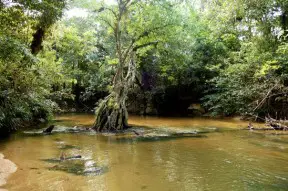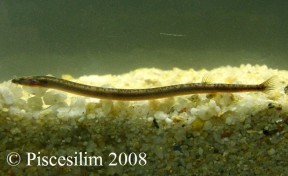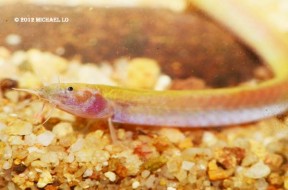Pangio doriae
SynonymsTop ↑
Eucirrhichthys doriae Perugia, 1892
Classification
Order: Cypriniformes Family: Cobitidae
Distribution
Described from the Malaysian state of Sarawak, Borneo and also known from Peninsular Malaysia.
The population inhabiting the Batang Hari river drainage, Sumatra was formerly identified as P. doriae but described as P. bitaimac by Tan and Kottelat (2009). Kottelat and Lim (1993) had previously noted that the Sumatran fish had a more slender body shape and more caudal-fin rays than those from Peninsular Malaysia and Sarawak.
Habitat
Most commonly found in shallow, slow-moving sections of forest streams or other calm habitats such as swamps, oxbows, and backwaters.
Many such environments are associated with ancient peat swamps and contain black water although it’s also found in clear waters which may or may not be tannin-stained to some extent.
Such habitats are typically shaded from the sun by marginal vegetation and the tree canopy above.
The water has a negligible dissolved mineral content, is poorly-buffered and pH can be as low as 3.0 or 4.0 due to release of tannins and organic acids from decaying organic material. Depending on locality the substrate may be composed of peat, mud or sand with the fish typically abundant in piles of leaf litter.
P. doriae is found living syntopically with various congeners across much of its range and in the Endau river drainage, southeastern Peninsular Malaysia sympatric fishes include Brevibora dorsiocellata, Rasbora cephalotaenia, R. einthovenii, R. dusonensis, R. paucisqualis, Puntius johorensis, P. partipentazona, Trigonopoma gracile, T. pauciperforatum, Betta pugnax, Sphaerichthys osphromenoides, Acanthopsoides molobrion, Vaillantella maassi, Pangio cuneovirgata, P. filinaris, P. malayana, P. piperata and P. shelfordii.
Maximum Standard Length
80 – 90 mm.
Aquarium SizeTop ↑
An aquarium with base measurements of at least 60 ∗ 30 cm or equivalent is recommended.
Maintenance
Use a soft, sandy substrate since this species likes to dig and tends to spend some of its time completely buried. When coarser gravel is used it may become stressed or damage itself, and feeding behaviour can be inhibited.
A few driftwood roots and branches, placed in such a way that plenty of shady spots are formed, can be used to add structure to the display and addition of dried leaf litter would provide additional cover and aid in simulating natural conditions.
Fairly dim lighting is also preferable and aquatic plants such as Microsorum, Taxiphyllum, and Cryptocoryne spp. can be added.
Gentle filtration providing a little surface agitation is adequate and high flow rates best avoided. Ensure that small specimens are unable to enter filter intakes and cover the tank well as most loaches do jump at times, especially when introduced to a new environment.
Water Conditions
Temperature: 21 – 26 °C
pH: 3.5 – 7.0
Hardness: 0 – 143 ppm
Diet
Chiefly a micropredator sifting mouthfuls of substrate through the mouth and gills from which insect larvae, small crustaceans and suchlike are extracted with a proportion of the natural diet also likely to comprise organic detritus and plant material from the gut contents of prey.
In the aquarium it will accept sinking dried foods but should also be offered regular meals of live and frozen Daphnia, Artemia, bloodworm, micro worm, grindal worm, etc.
Behaviour and CompatibilityTop ↑
Pangio spp. are peaceful both with one another and other fishes and there exist no reports of them harming tankmates though they may prey on eggs or fry.
In nature they’re often found in large aggregations and in captivity will often pack themselves into a single nook, cranny or cave when at rest, so a group of at least 5-6 specimens should be the minimum purchased.
Small, peaceful species from similar environments such as Boraras, Sundadanio, smaller Rasbora, Trichopsis, Sphaerichthys, Kottelatlimia, etc., constitute the best tankmates.
Some sand-dwelling loaches from the family Nemacheilidae are also suitable but proper research is essential as some can be excessively competitive, territorial or otherwise aggressive.
Sexual Dimorphism
In mature males the first pectoral-fin ray is branched and thickened, while the pectoral fins themselves are noticeably upturned and longer than those of females.
Adult females are typically heavier-bodied and a little larger then males.
Reproduction
Unrecorded.
NotesTop ↑
One of a handful of Pangio spp. traded under the generic name ‘eel loach’, though it’s most commonly available as bycatch among shipments of other fishes.
Some authors have suggested it may be synonymous with P. anguillaris but it can be told apart by possessing a pair of prominent nasal barbels (vs. no nasal barbels in P. anguillaris).
It’s included in the P. anguillaris group of closely-related species within the genus and can be distinguished from other members P. bitaimac by presence of scales on the cheeks (vs. absence), P. lidi by presence of pelvic fins (vs. absence), and P. lumbriciformis by lack of dark saddle-shaped markings on the body (vs. presence).
Kottelat and Lim (1993) suggested that the P. anguillaris group is one of four such assemblages within the genus alongside the P. kuhlii, P. oblonga and P. shelfordii groups, and this unofficial system was followed until Bohlen et al. (2011) published a molecular phylogenetic analysis including 18 recognised species plus a number of undescribed ones.
Their results suggest the existence of three, rather than four, major lineages within the genus; the P. anguillaris and P. shelfordii groups represent two of them with Kottelat and Lim’s P. kuhlii and P. oblonga groups together forming the third.
Within this third lineage are three sublineages formed by P. filinaris, an apparently undescribed fish from the Temburong River in Brunei referred to as P. cf. oblonga IV, and all other species in the group, respectively.
Other species in the P. anguillaris group include P. anguillaris, P. bitaimac, P. lidi, P. lumbriciformis and possibly P. signicauda. They’re most obviously separated from those of the P. shelfordii and P. kuhlii–oblonga groups by their high vertebral count and vermiform (worm-like), usually patternless, greyish-coloured bodies.
Pangio is among the most speciose cobitid genera and widespread throughout South and Southeast Asia with species diversity thought to be considerably greater than currently recognised.
Pangio species are often generically referred to as ‘kuhli’ or ‘coolie’ loaches in the aquarium hobby, the latter a variation of the former which was itself derived from the surname of German naturalist Heinrich Kuhl (1797-1821). Ichthyologists tend to refer to them as ‘eel loaches’.
They’re distinguished from other cobitids by their long, slender body shape, relatively high number of vertebrae and the position of the dorsal-fin which is situated well behind the origin of the pelvic fins (vs. in front of, above or only slightly behind).
Several described members were previously included in the genus Acanthophthalmus which Kottelat (1987) demonstrated to be a syonym of Cobitis, and he chose the replacement name Pangio in preference to its simultaneous synonym Apua (Blyth, 1860).
Myers (1929) placed P. anguillaris as type species of Cobitophis, a grouping containing the very elongate species, while Perugia (1892) originally described P. doriae in the genus Eucirrhichthys. The former was synonymised with Acanthophthalmus by Nalbant (1963) and the latter by Roberts (1989).
The family Cobitidae, often referred to as ‘true’ loaches, is widely-distributed across most of Eurasia with the Indian subcontinent, Southeast Asia and China representing particular centres of species diversity.
Phylogenetic analyses by Tang et al. (2006), Šlechtová et al. (2007) and Šlechtová et al. (2008) revealed that the group constitutes a separate genetic lineage to the family Botiidae (the two were previously grouped together under Cobitidae as subfamilies Cobitinae and Botiinae).
In the most recent study Pangio was found to be more closely affiliated with Acantopsis, Acanthopsoides and Kottelatlimia than Lepidocephalichthys as had been previously hypothesised.
All cobitids possess sharp, motile, sub-ocular spines which are normally concealed within a pouch of skin but erected when an individual is stressed, e.g. if removed from the water. Care is therefore necessary as these can become entangled in aquarium nets and with larger species even break human skin.
References
- Bohlen, J., V, Šlechtová, H. H. Tan and R. Britz, 2011 - 854-865: Molecular Phylogenetics and Evolution 61(3)
Phylogeny of the Southeast Asian freshwater fish genus Pangio (Cypriniformes; Cobitidae). - Britz, R. and J. Maclaine, 2007 - Ichthyological Exploration of Freshwaters 18(1): 17-30
A review of the eel-loaches, genus Pangio, from Myanmar (Teleostei: Cypriniformes: Cobitidae). - Britz, R. and M. Kottelat, 2010 - Ichthyological Exploration of Freshwaters 20(4): 317-376
Pangio longimanus, a miniature species of eel-loach from central Laos (Teleostei: Cypriniformes: Cobitidae). - Burridge, M. E., 1992 - Copeia 1992(1): 172-186
Systematics of the Acanthophthalmus kuhlii complex (Teleostei: Cobitidae), with the description of a new species from Sarawak and Brunei. - Hadiaty, R. K. and M. Kottelat, 2009 - Zootaxa 2171: 65-68
Pangio lidi, a new species of loach from eastern Borneo, Indonesia. - Kottelat, M., 2012 - Raffles Bulletin of Zoology Supplement 26: 1-199
Conspectus cobitidum: an inventory of the loaches of the world (Teleostei: Cypriniformes: Cobitoidei). - Kottelat, M. and K. K. P. Lim, 1993 - Raffles Bulletin of Zoology 41(2): 203-249
A review of the eel-loaches of the genus Pangio (Teleostei: Cobitidae) from the Malay Peninsula, with descriptions of six new species. - Ng, H. H. and H.-H. Tan, 1999 - Zoological Studies 38(3): 350-366
The fishes of the Endau drainage, Peninsular Malaysia with descriptions of two new species of catfishes (Teleostei: Akysidae, Bagridae). - Roberts, T. R., 1989 - Memoirs of the California Academy of Sciences 14: i-xii + 1-210
The freshwater fishes of Western Borneo (Kalimantan Barat, Indonesia). - Tan, H. H. and M. Kottelat, 2009 - Ichthyological Exploration of Freshwaters 20(1): 13-69
The fishes of the Batang Hari drainage, Sumatra, with description of six new species. - Tang, Q., H. Liu, R. Mayden and B. Xiong, 2006 - Molecular Phylogenetics and Evolution 39(2): 347-357
Comparison of evolutionary rates in the mitochondrial DNA cytochrome b gene and control region and their implications for phylogeny of the Cobitoidea (Teleostei: Cypriniformes). - Šlechtová, V., J. Bohlen and A. Perdices, 2008 - Molecular Phylogenetics and Evolution 47(2): 812-831
Molecular phylogeny of the freshwater fish family Cobitidae (Cypriniformes: Teleostei): delimitation of genera, mitochondrial introgression and evolution of sexual dimorphism. - Šlechtová, V., J. Bohlen and H. H. Tan, 2007 - Molecular Phylogenetics and Evolution 44(3): 1358-1365
Families of Cobitoidea (Teleostei; Cypriniformes) as revealed from nuclear genetic data and the position of the mysterious genera Barbucca, Psilorhynchus, Serpenticobitis and Vaillantella.








